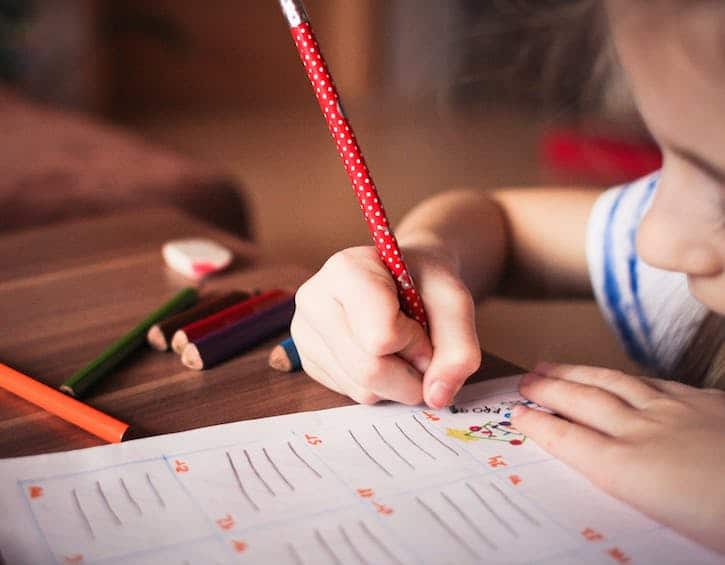
Writing tips and storytelling games to inspire your child’s creativity
Getting your kid to write can be a chore. It’s one of the most important skills they will need in life, but aside from seeing it as just an everyday tool, how can you get them to actually enjoy the process? Creative writing is great for helping your kids think creatively, logically and build their language ability.
Writing assignments can help children practise their self-expression but they can easily become a source of tension when your child stubbornly insists, “I can’t think of anything!” You don’t want to spoon-feed them the whole thing. It’s frustrating, it’s boring (for both of you), and your child spends a lot of time writing without really learning how to write.
Instead, check out the tips below to build up your child’s creativity. They’re fun and easy, and they’ll save you from the hair-pulling experience of telling your child to “Just think of something!”.
Read more: Raising a Reader: How to Instil a Love of Reading to Your Child

Away From The Desk
Pressure never helps anyone feel creative. If a child isn’t comfortable thinking in that manner, a blank page in front of them that needs to be filled can feel like an enormous challenge. Try to build more creativity into your daily interactions with your child, and soon it will come more naturally to them, and they’ll even learn to enjoy it.
Pocket Stories
Empty out your pockets (or dig around the bottom of your handbag) and make a story about the items you find. Everyday objects soon turn into something far more exciting; “One day, Sally found a $10 coin in her shoe. She took it out and went to the shop to buy some candy. As Sally walked out of the store, she felt something hard and round inside her shoe. It was the $10 coin again. She felt scared, and she wrapped it up in a piece of tissue…’ You get the idea. Take turns with your child to tell these pocket stories, and they’ll soon get the hang of generating a quick story.
Emoji Mania
You and your child have one minute to draw as many emoji faces as you can. Then swap your pieces of paper and tell a story in which a character has all of the emotions on the paper. “Josh’s teacher called him to the front of the class to read out his story. He felt very nervous, and his legs shook as he walked from his seat. When he opened his book to read, he was shocked to find that the pages were blank…” You can cross the faces off as you tell the story, which is also great training for following a writing plan.

Impromptu Haiku
Challenge each other to make up a haiku about the things which you see around you. “My pen is yellow. I got it for my birthday. It is my favourite.” This game helps develop descriptive skills and quick thinking, and can be played whenever you have a free moment, wherever you are.
Fill In The Blanks
Did you ever play Mad Libs when you were a kid? If so, you know how fun this exercise can be. Take a poem/story/article and black out or cover some of the words. Think of creative ways to fill in the blanks. “Alice was beginning to get very _______________ of sitting by her sister on the _______________, “ etc. etc. You can also do this with stories which you read aloud or which you make up together. Try telling a story to your child and pausing to let them choose the next plot point for themselves, e.g. location, animal, person.
Unusual Uses
Imagine an alien has found something in your bedroom/living room/bag, but they don’t know what its real use is. How would they mistakenly use that object? “This stick has lots of pointy brittles sticking out of it and I’ve seen a woman patting her head with it. It must be some sort of brain-altering device.” Take it in turns to be the alien, and try to be as descriptive as you can while you use the object. We love this one as it has the potential to get very silly, very quickly. All in the name of creativity!

At The Desk
When it’s time to sit down and start writing, you can ease your child’s way into the task by doing one of the games above. Then, when they’re in a creative frame of mind, try to use the strategies below to help your child plan and complete their writing.
It doesn’t matter if they get half way through the story and decide to change some of the details which they’ve planned. That’s fine! It’s all about helping them judge between good and bad ideas.
Finish the Picture
Draw a simple squiggle on a piece of paper. Your child then has to turn the squiggle into something (e.g. an animal/character/building) and also add another squiggle to the page. Take turns to change each other’s squiggles into pictures. As you’re drawing, talk about what could be happening in the picture. This is a great way to take a child who has “no ideas” to one who’s bursting with story plots and character descriptions.

Story Dice
You can find story cubes in stores, or make your own version using paper. These dice need simple pictures or words on each side, which you would roll to put story ideas together. They’re also excellent to use when your child gets writer’s block. Give them two rolls of the dice and make them pick between one of the words or pictures which come out.
Comic Strip
Draw five boxes in a row on a piece of paper. In the first box, your child needs to draw two characters and their location. In the second, one of the characters should have a small problem. In the third box, this develops into a crisis. In the next box, the characters must fix this crisis. The last box should show the characters in their “happily ever after”. This is now the story plan they can follow easily in their writing.
Word-finder
Write a random selection of 12 letters on a piece of paper and ask your child to make as many words as possible in two minutes using each letter as the first letter of each word. When they have their words, they then have to fit all 12 of them in to their story.
Flip a Coin
When your child doesn’t know what to write, give them two options and flip a coin to decide. The ideas can be as simple as what season it is, or whether the main character kills the dragon in the end. Often, your child will tweak your ideas to turn them into something they are excited to write about. Soon enough, they’ll be able to generate ideas all on their own!
Happy writing!
 View All
View All











 View All
View All





 View All
View All


 View All
View All










